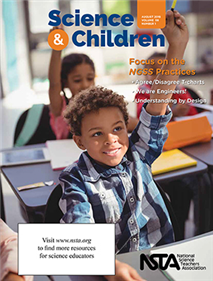All Disciplinary Core Ideas resources
Lesson Plan
Journal Article
Atmospheric Scientist Shawn Urbanski
Atmospheric scientists study the chemical composition of the atmosphere. More specifically, they look at how atmospheric gases, liquids, and solids interact both with each other and with the earth’s surface. This helps people understand such phenom...
By Luba Vangelova
Blog Post
Arguing From Evidence to Discover the ‘Why’
In my science classroom, students look at evidence all the time. Sometimes it is in photos or videos; sometimes in charts and graphs; and sometimes we generate our own data through investigations. A more traditional approach previously used is asking...
By Rebecca Schumacher
Blog Post
Designing Engineering Projects That Teach Science Concepts by Cory Culbertson
Lately I’ve been thinking a lot about the engineering projects in my courses. On the surface, they don’t seem like something I need to worry about. My students love these projects and talk about them all year. My administration likes the student-...
By Cory Culbertson
Blog Post
Linking Science and Engineering Through Good Questions
Engineering design projects are a wonderful opportunity for students to develop science disciplinary core ideas (DCIs). (As many of you know, with the release of the NGSS, learning in engineering must be integrated with developing DCIs in physical, l...
By Greg Bartus
Blog Post
I first encountered the KLEWS teaching strategy in an article in Science and Children (NSTA 2015), “KLEWS to Explanation-Building in Science.” I shared the article and modeled the strategy with teachers who wanted to support their K–5 students ...
Journal Article
Science 101: What’s Wrong With “For Every Action, There is an Equal and Opposite Reaction”?
This column provides background science information for elementary teachers. This issue explores Newton's third law of motion....
Journal Article
Methods and Strategies: Scaffolding for Failure
This column provides ideas and techniques to enhance your science teaching. This issue helps students navigate Engineering Design Failure. ...
Blog Post
Exploring Structure and Function in Insects
As an entomologist, one of my greatest challenges is trying to overcome my students’ feelings of fear and disgust regarding insects. Insects often have negative images in society. Walk through any toy store, and you will likely find plastic insects...
By Cindy Workosky
Blog Post
Using Toxic Algal Blooms to Teach Structure and Function
Young children often experience a developmental stage in which they question everything. Why aren’t there dinosaurs anymore? Why do cats purr? Why are some potato chips green? They go from simply observing their surroundings to analyzing, experimen...
By Rebecca Brewer
Journal Article
The Early Years: Making Sense of Their World
This column discusses resources and science topics related to students in grades preK to 2. In this issue students document the apparent movement of the Sun by making and recording two daily observations for a period of time and looking for a patter...
Blog Post
Global Thinking Inside and Outside the Classroom
Dynamic Equilibrium. These two words represent what is essential in teaching Earth science: the idea that forces are constantly working against one another, but often do so in ways that nearly counteract one another....
By Cindy Workosky





